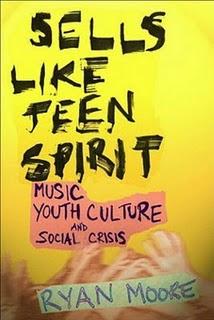Sells Like Teen Spirit: Music, Youth Culture and Social Crisis

Punk, hardcore, and alternative rock music scenes have been for years the almost exclusive realm of teenagers and youth in their twenties. Not only have they been areas of creative expression, but such subcultures have given young people a place to challenge beauty standards, political boundaries, and cultural norms.
In Sells Like Teen Spirit, author Ryan Moore documents the music scenes of the 1980s and early 1990s, as well as their evolutions today. From metal to Riot Grrrl, Moore talks about the players and the stories that made youth music cultures what they were during these times. Moore also delves into the sociopolitical moment to relate how the dominant cultural debates directly and indirectly shaped youth music cultures. Generations-old struggles, such as sexism, also played prominently in many subcultures.
Most notable in this book, Moore explores an interesting subtext in youth music cultures that other writers in the midst of feminist research and study on race further explore. Namely, a wave of "post" approaches ("post-racial," "post-feminist") take a role in youth culture that, in spite of pretensions to the contrary, only replicates and supports traditional roles and power in white, patriarchal American society. For instance, the alternative fashion model Suicide Girls trend of a few years ago presents women from youth subcultures (e.g., punk and goth) as different, empowered female pin-ups. Such images intended to impart a view of women as self-assured, independent, sexually liberated creatures; however, the essential conversation of this image—women fitting into a male perception of beauty presented primarily as objects for male consumption—remains intact.
Men, in virtually all alternative youth music cultures, assume a position that fundamentally affirms the patriarchal position: strong, individualistic characters navigating a world in which white male hegemony is crumbling amid globalization. Moore points out the revival of swing, ska and rockabilly imagery harkens back to times in which men were the makers of their fortunes whereas today corporate power and economic uncertainty dimmed hopes and dreams of millions.
Yet many outgrowths of youth music subcultures offered refreshing challenges to the worlds in which young people grew up. Bands like Bikini Kill and the women’s zine scene are explored in Sells Like Teen Spirit, to give another perspective of young people committed to challenging power, as others before them, through their talents and passion.
Though not as expansive as similarly themed books like There’s A Riot Going On or Can’t Stop, Won’t Stop, for those interested in intersections of youth culture, music, and politics, Sells Like Teen Spirit is a good text to understand or reminisce about music subcultures that were special, though could not overcome the conundrum that stymied subcultures before them: how to use the youth music subculture make substantive political, cultural, and social change.